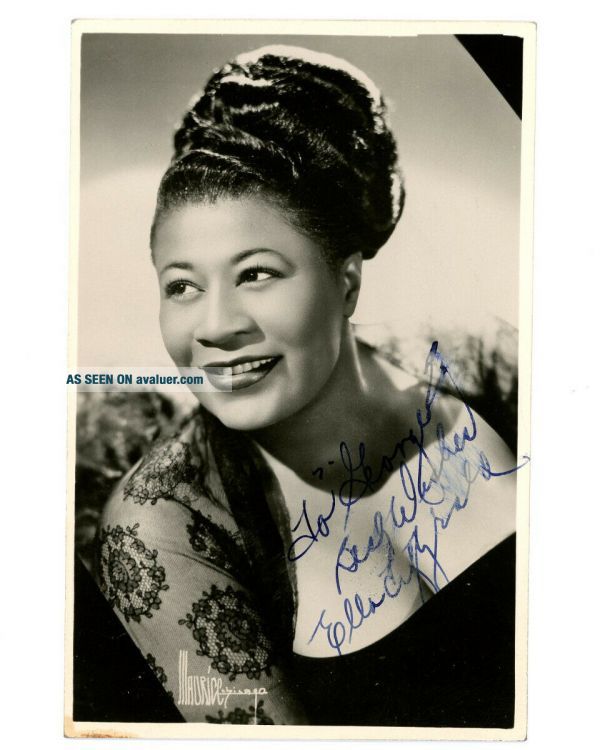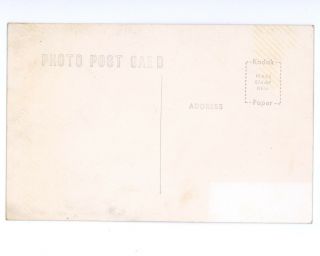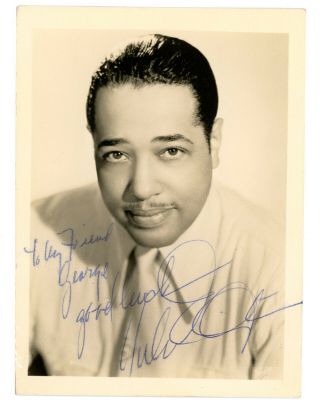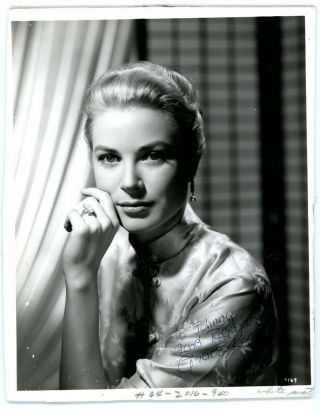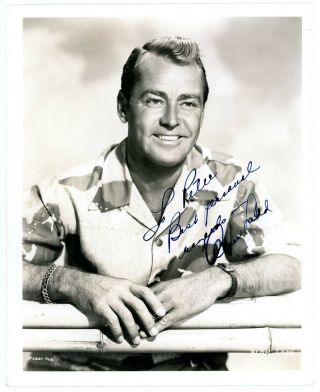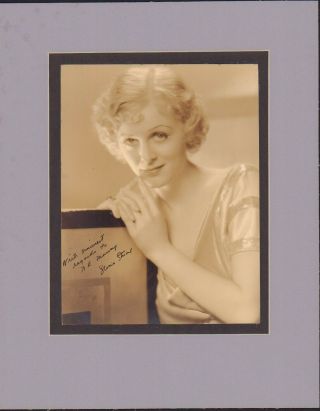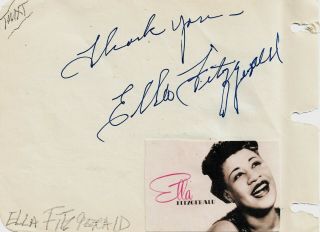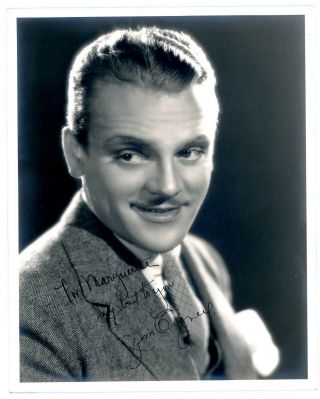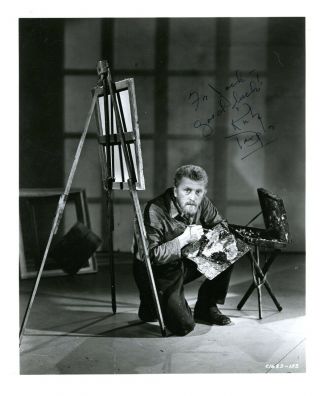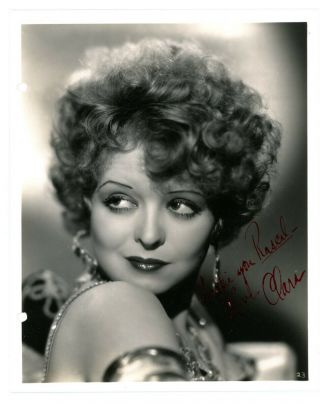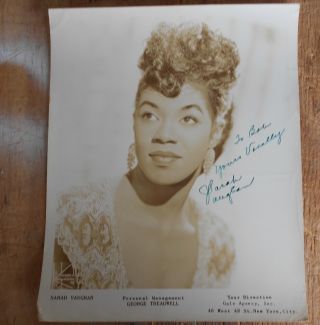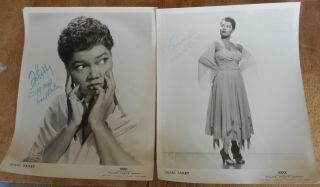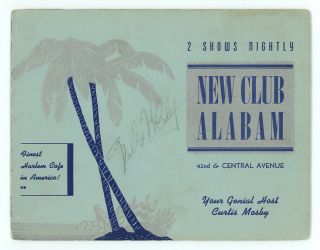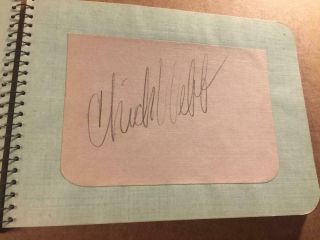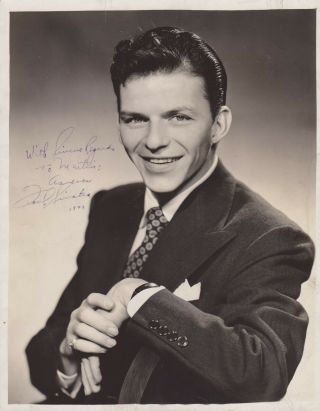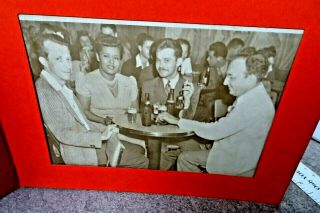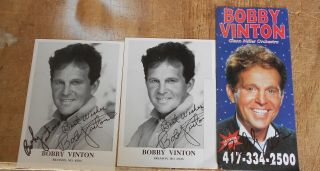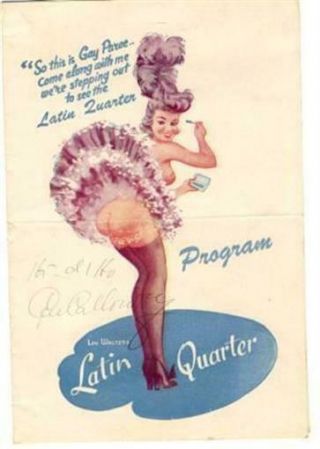ELLA FITZGERALD VINTAGE 1950s SIGNED DBLWT PHOTOGRAPH AUTOGRAPHED UACC
Item History & Price
HIGHLY RECOMMENDED - GREAT EXAMPLE: Jazz legend ELLA FITZGERALD a...uthentic original hand signed vintage 1950s gelatin silver heavyweight photograph. Autograph is written with a blue ink fountain pen.
- This autographed item has beenauthenticated by MY MOVIEMEMORABILIA & MORE, a UACC (Universal Autograph Collectors Club)Registered Dealer (No. RD320), which must abide by the UACC Code of Ethics, allpolicies that the UACC has enacted and must have a good standing as a reputabledealer recommended by long-term UACC dealers. We have years of selling tobuyers internationally with a 100% positive feedback. All of my autographed items have a lifetime money back guarantee ofauthenticity (see Return Policy).- SIZE: approx. 5 1/2" X 3 1/2"
- TONE: sepia toned B&W- FINISH: glossy- OTHER: double-weight
_______________________________________________________________________________
SHIPPING TERMS
- I ship all items using, what I call, triple protection packing. The photos are inserted into a display bag with a white board, then packed in between two thick packaging boards and lastly wrapped with plastic film for weather protection before being placed into the shipping envelope.
- The shipping cost for U.S. shipments includes USPS "Delivery Confirmation" tracking.
- Combined Shipping Discounts: If you purchase more than one item within a two week period that will be shipped together just add $2.00 to the base shipping cost. This will cover any additional quantity of a similar item purchased. If you purchase different types of items (i.e. clothes and photos) please contact me for the lowest possible shipping discount. Please wait for me to issue the invoice with the reduced shipping cost before making payment.
PAYMENT TERMS
- Please pay within three (3) days of purchase.
- I reserve the right to re-list the item(s) if payment is not received within seven (7) days.
- All sales taxes applicable to the City of Los Angeles, State ofCalifornia and the 2019 Marketplace Sales Tax Law in other states shall beapplied.
CUSTOMER SERVICE
I will respond to all inquiries within 24 hours. Please feel free to contact me anytime at 1-310-880-8140 (Pacific Standard Time)
ELLA FITZGERALD BIO Ella JaneFitzgerald(April 25, 1917 ? June 15, 1996), also known as the "First Lady of Song" and "Lady Ella, " was an American jazz and song vocalist.[1] With a vocal range spanning threeoctaves (Db3 to Db6), she was notedfor her purity of tone, impeccablediction, phrasing and intonation, and a "horn-like" improvisationalability, particularly in her scatsinging.She isconsidered to be a notable interpreter of the Great American Songbook. Over a recording career that lasted 59 years, she was the winner of 13 Grammy Awards and wasawarded the National Medal of Art by Ronald Reagan and the Presidential Medalof Freedom by George H. W. Bush.Fitzgeraldwas born in Newport News, Virginia, the child of a common-law marriage between Williamand Temperance "Tempie" Fitzgerald.The pair separated soon after her birth and she and her mother went to Yonkers, N.Y, where they eventually moved in with Tempie'slongtime boyfriend Joseph Da Silva.Fitzgerald's half-sister, Frances DaSilva, was born in 1923.In her youthFitzgerald wanted to be a dancer, although she loved listening to jazz recordings by Louis Armstrong, Bing Crosby and The Boswell Sisters. She idolized the lead singer Connee Boswell, later saying, "My mother brought home one of her records, and I fell in love with it....I tried so hard to sound just like her." In 1932, her mother died from a heart attack. Following this trauma, Fitzgerald's grades dropped dramatically and she frequently skipped school. Abused by her stepfather, she was first taken in by an aunt and atone point worked as a lookout at a bordello and also with a Mafia-affiliatednumbers runner. When the authoritiescaught up with her, she was firstplaced in the Colored Orphan Asylum in Riverdale, the Bronx.However, when the orphanage provedtoo crowded she was moved to the New YorkTraining School for Girls in Hudson, New York, a state reformatory. Eventually sheescaped and for a time was homeless.She made hersinging debut at 17 on November 21, 1934 at the Apollo Theater. in Harlem, New York.She pulled in a weekly audience at the Apollo and won the opportunity tocompete in one of the earliest of its famous "Amateur Nights". She had originally intended to go on stage anddance but, intimidated by theEdwards Sisters, a local dance duo, she opted to sing instead in the style of ConneeBoswell. She sang Boswell's"Judy" and "The Object of My Affection, "a song recorded by the Boswell Sisters, and won the first prize of US$25.00. Fitzgeraldmarried at least twice, and there isevidence that she may have married a third time.In 1941 she married Benny Kornegay, a convicted drug dealer and local dockworker.The marriage was annulled after two years.Her secondmarriage, in December 1947, was to the famous bass player Ray Brown, whom she had met while on tour with DizzyGillespie's band a year earlier.Together they adopted a child born to Fitzgerald's half-sister, Frances, whom they christened Ray Brown, Jr. With Fitzgerald and Brown often busy touring andrecording, the child was largelyraised by her aunt, Virginia. Fitzgerald and Brown divorced in 1953, bowing to the various career pressures both wereexperiencing at the time, thoughthey would continue to perform together.In July 1957, Reuters reported that Fitzgerald had secretlymarried Thor Einar Larsen, a youngNorwegian, in Oslo.She had even gone as far as furnishing an apartment in Oslo, but the affair was quickly forgotten when Larsenwas sentenced to five months hard labor in Sweden for stealing money from ayoung woman to whom he had previously been engaged.Fitzgeraldwas also notoriously shy. Trumpetplayer Mario Bauza, who playedbehind Fitzgerald in her early years with Chick Webb, remembered that "she didn?t hang out much.When she got into the band, she wasdedicated to her music?.She was alonely girl around New York, just kept herself to herself, for the gig." When, later in her career, the Society of Singers named an award after her, Fitzgerald explained, "I don'twant to say the wrong thing, which Ialways do. I think I do better whenI sing." Alreadyvisually impaired by the effects of diabetes, Fitzgerald had both her legs amputated in 1993.In 1996 she died of the disease in Beverly Hills, California at the age of 79. She is buried in the InglewoodPark Cemeteryin Inglewood, California. The career history and archival material fromElla's long career are housed in the Archives Center at theSmithsonian's National Museum of American History while her personal musicarrangements are at The Library of Congress.Her extensive cookbook collection was donated to the Schlesinger Library at Harvard University while her published sheetmusic collection is at the Schoenberg Library at UCLA.In January1935, Fitzgerald won the chance toperform for a week with the Tiny Bradshaw band at the Harlem Opera House. She met drummer and bandleader Chick Webb here. Webb had already hired singer Charlie Linton towork with the band and was, TheNew York Times later wrote, "reluctant to sign her....because she was gawky and unkempt, a diamond in the rough."Webb offered her the opportunity to test with his band when they played a danceat Yale University.She begansinging regularly with Webb's Orchestra through 1935 at Harlem'sSavoy Ballroom. Fitzgerald recordedseveral hit songs with them, including "Love and Kisses" and "(If You Can't Sing It) You'llHave to Swing It (Mr.Paganini)". But it was her 1938version of the nursery rhyme, "A-Tisket, A-Tasket", a song she co-wrote, that brought her wide public acclaim.Chick Webbdied on June 16, 1939, and his band was renamed "Ella Fitzgerald andher Famous Orchestra" with Ella taking on the role of bandleader. Fitzgerald recorded nearly 150 sides during hertime with the orchestra, most ofwhich, like "A-Tisket, A-Tasket, "were "novelties and disposable pop fluff."In 1942, Fitzgerald left the band to begin a solo career. Now signed to the Decca label, she had several popular hits while recording withsuch artists as the Ink Spots, LouisJordan, and the Delta Rhythm Boys.With Decca'sMilt Gabler as her manager, shebegan working regularly for the jazz impresario Norman Granz, and appeared regularly in his Jazz at thePhilharmonic (JATP) concerts.Fitzgerald's relationship with Granz was further cemented when he became hermanager, although it would be nearlya decade before he could record her on one of his many record labels.With thedemise of the Swing era and the decline of the great touring big bands, a major change in jazz music occurred. The advent of bebop led to new developments inFitzgerald's vocal style, influencedby her work with Dizzy Gillespie's big band.It was in this period that Fitzgerald started including scat singing as a majorpart of her performance repertoire.While singing with Gillespie, Fitzgerald recalled, "I justtried to do [with my voice] what I heard the horns in the band doing." Her 1945scat recording of Flying Home (arranged by Vic Schoen) would later be describedby The New York Times as "one of the most influential vocal jazzrecords of the decade....Where other singers, most notably Louis Armstrong, hadtried similar improvisation, no onebefore Miss Fitzgerald employed the technique with such dazzling inventiveness." Her bebop recording of "Oh, Lady be Good!" (1947) was similarly popularand increased her reputation as one of the leading jazz vocalists.Perhapsresponding to criticism and under pressure from Granz, who felt that Fitzgerald was given unsuitable material to record during thisperiod, her last years on the Deccalabel saw Fitzgerald recording a series of duets with pianist Ellis Larkins, released in 1950 as Ella Sings Gershwin.Fitzgeraldwas still performing at Granz's JATP concerts by 1955.Fitzgerald left Decca and Granz, nowher manager, created Verve Recordsaround her.Fitzgeraldlater described the period as strategically crucial, saying, "I had gotten to thepoint where I was only singing be-bop.I thought be-bop was 'it, ' and thatall I had to do was go some place and sing bop.But it finally got to the point where I had no place to sing. I realized then that there was more to music thanbop. Norman....felt that I should do other things, so he produced The Cole Porter Songbookwith me. It was a turning point inmy life." EllaFitzgerald Sings the Cole Porter Songbook, released in 1956, was the first of eight multi-album Songbook setsFitzgerald would record for Verve at irregular intervals from 1956 to 1964. The composers and lyricists spotlighted on eachset, taken together, represent the greatest part of the cultural canonknown as the Great American Songbook.Fitzgerald's song selections ranged from standards to rarities and representedan attempt by Fitzgerald to cross over into a non-jazz audience.EllaFitzgerald Sings the Duke Ellington Songbook was the only Songbook on which thecomposer she interpreted played with her.Duke Ellington and his longtime collaborator Billy Strayhorn both appeared onexactly half the set's 38 tracks and wrote two new pieces of music for thealbum: "The E and D Blues" and a four-movement musical portrait ofFitzgerald (the only Songbook track on which Fitzgerald does not sing).The Songbookseries ended up becoming the singer's most critically acclaimed andcommercially successful work, andprobably her most significant offering to American culture. The New York Times wrote in 1996, "These albums were among the first poprecords to devote such serious attention to individual songwriters, and they were instrumental in establishing the popalbum as a vehicle for serious musical exploration."A few daysafter Fitzgerald's death, NewYork Times columnist Frank Rich wrote that in the Songbook seriesFitzgerald "performed a cultural transaction as extraordinary as Elvis'scontemporaneous integration of white and African-American soul. Here was a black woman popularizing urban songsoften written by immigrant Jews to a national audience of predominantly whiteChristians."[6]Frank Sinatra was moved out of respect for Fitzgerald to block Capitol Recordsfrom re-releasing his own recordings in a similar, single composer vein.EllaFitzgerald also recorded albums exclusively devoted to the songs of Porter andGershwin in 1972 and 1983; the albums being, respectively, Ella Loves Coleand Nice Work If You Can Get It.A later collection devoted to a single composer was released during her timewith Pablo Records, Ella AbraçaJobim, featuring the songs ofAntonio Carlos Jobim.Whilerecording the Songbooks and the occasional studio album, Fitzgerald toured 40 to 45 weeks per year in the United States and internationally, under the tutelage of Norman Granz. Granz helped solidify her position as one of theleading live jazz performers. In themid-1950s, Fitzgerald became thefirst African-American to perform at the Mocambo, after Marilyn Monroe had lobbied the owner for the booking. The booking was instrumental in Fitzgerald'scareer. The incident was turned intoa play by Bonnie Greer in 2005.There areseveral live albums on Verve that are highly regarded by critics. Ella at the Opera House shows a typicalJATP set from Fitzgerald. Ella inRome and Twelve Nights In Hollywood display her vocal jazz canon. Ella in Berlin is still one of her bestselling albums; it includes a Grammy-winning performance of "Mack theKnife" in which she forgets the lyrics, but improvises magnificently to compensate.Unlike anyother singer you could name, Fitzgerald has the most amazing asset in the very sound of her voice: it'seasily one of the most beautiful and sonically perfect sounds known to man. Even if she couldn't do anything with it, the instrument that Fitzgerald starts with isdulcet and pure and breathtakingly beautiful.As Henry Pleasants has observed, shehas a wider range than most opera singers, and many of the latter, includingDietrich Fischer-Dieskau, are amongher biggest fans. And the intonationthat goes with the voice is, to putit conservatively, God-like. Fitzgerald simply exists in tune, and she hits every note that there is without theslightest trace of effort. Othersingers tend to sound like they're trying to reach up to a note - Fitzgeraldalways sounds like she's already there.If anything, she's descending fromher heavenly perch and swooping down to whatever pitch she wants. HenryPleasants, an Americanclassical-music critic, wrote thisabout her:She has alovely voice, one of the warmest andmost radiant in its natural range that I have heard in a lifetime of listeningto singers in every category. Shehas an impeccable and ultimately sophisticated rhythmic sense, and flawless intonation.Her harmonic sensibility is extraordinary.She is endlessly inventive.. . it isnot so much what she does, or eventhe way she does it, it's what shedoes not do. What she does not do, putting it simply as possible, is anything wrong.There is simply nothing in performance to which one would take exception.. . Everything seems to be just right. One would not want it any other way. Nor can one, for a moment imagine it any other way.EllaFitzgerald had an extraordinary vocal range.A mezzo-soprano (who sang much lower than most classical contraltos), she had a range of ?2 octaves and a sixth from alow D or D flat to a high B flat and possibly higher?.VerveRecords was sold to MGM in 1963 for $3 million and in 1967 MGM failed to renewFitzgerald's contract. Over the nextfive years she flitted between Atlantic, Capitol and Reprise.Her material at this time represents a departure from her typical jazzrepertoire. For Capitol she recordedBrighten the Corner, an albumof hymns, Ella Fitzgerald'sChristmas, an album oftraditional Christmas carols, MistyBlue, a country andwestern-influenced album, and 30by Ella, a series of six medleysthat fulfilled her obligations for the label.During thisperiod, she had her last US chartsingle with a cover of Smokey Robinson's "Get Ready", previously a hit for The Temptations, and some months later a top-five hit for RareEarth.The surprisesuccess of the 1972 album Jazz at Santa Monica Civic '72 led Granz to found Pablo Records, his first record label since the sale of Verve. Fitzgerald recorded some 20 albums for the label. Ella in London recorded live in 1974 withpianist Tommy Flanagan, Joe Passon guitar, Keter Betts on bass andBobby Durham on drums is one of her best ever.Her years on Pablo documented the decline in her voice."She frequently used shorter, stabbing phrases, and her voice washarder, with a wider vibrato, " one biographer wrote.Plagued by health problems, Fitzgerald made her last recording in 1991 and her last public performances in1993. Miss Fitzgeraldwas generous throughout her career, and in 1993, she established theCharitable Foundation that bears her name: The Ella Fitzgerald CharitableFoundation, which continues to helpthe disadvantaged through grants and donation of new books to at-risk children.In her mostnotable screen role, Fitzgeraldplayed the part of singer Maggie Jackson in Jack Webb's 1955 jazz film PeteKelly's Blues. The filmcostarred Janet Leigh and singer Peggy Lee.Even though she had already worked in the movies (she had sung briefly in the1942 Abbott and Costello film Ride 'Em Cowboy), she was "delighted" when Norman Granz negotiated the role for her, and, "at the time....considered her role in the Warner Brothers moviethe biggest thing ever to have happened to her."Amid The New York Times' pan of the film when it opened in August 1955, the reviewer wrote, "About five minutes (out of ninety-five) suggest the picture this mighthave been. Take the ingeniousprologue...Or take the fleeting scenes when the wonderful EllaFitzgerald, allotted a few spokenlines, fills the screen and soundtrack with her strong mobile features and voice."Similar toanother African-American jazz singer, Lena Horne, Fitzgerald's raceprecluded major big-screen success.After Pete Kelly's Blues, sheappeared in sporadic movie cameos, in St. Louis Blues (1958), and Let No Man Write My Epitaph (1960). Much later, she appeared in the 1980s television drama The White Shadow.She alsomade numerous guest appearances on television shows, singing on The Pat Boone Chevy Showroom, The Frank Sinatra Show, andalongside Nat King Cole, Dean Martin, Mel Tormé and many others.Perhaps her most unusual and intriguing performance was of the 'Three LittleMaids' song from Gilbert and Sullivan's comic operetta The Mikadoalongside Joan Sutherland and Dinah Shore on Shore's weeklyvariety series in 1963. Fitzgeraldalso made a one-off appearance alongside Sarah Vaughan and Pearl Bailey on a1979 television special honoring Bailey.In 1980, she performed a medley ofstandards in a duet with Karen Carpenter on the Carpenters' television program, Music, Music, Music.Fitzgeraldalso appeared in TV commercials, hermost memorable being an ad for Memorex.In the commercials, she sang a notethat shattered a glass while being recorded on a Memorex cassette tape. The tape was played back and the recording alsobroke the glass, asking "Is itlive, or is it Memorex?" Shealso starred in a number of commercials for Kentucky Fried Chicken, singing and scatting to the fast-food chain'slongtime slogan, "We do chickenright!" Her finalcommercial campaign was for American Express, in which she was photographed by Annie Leibovitz.Fitzgerald'smost famous collaborations were with the trumpeter Louis Armstrong, the guitarist Joe Pass, and the bandleaders Count Basie and Duke Ellington.Fitzgerald recorded three Verve studio albums with Armstrong, two albums of standards (1956's Ella and Louis and 1957's Ella and Louis Again), and a third album featured music from the Gershwin musical Porgy and Bess. Fitzgerald also recorded a number of sides with Armstrong for Decca in the early 1950s.Fitzgerald is sometimes referred to as the quintessential swing singer, and her meetings with Count Basie are highly regarded by critics. Fitzgerald features on one track on Basie's 1957 album One O'Clock Jump, while her 1963 album Ella and Basie! is remembered as one of her greatest recordings. With the 'New Testament' Basie band in full swing, and arrangements written by a young Quincy Jones, this album proved a respite from the 'Songbook' recordings and constant touring that Fitzgerald was engaged in during this period. Fitzgerald and Basie also collaborated on the 1972 album Jazz at Santa Monica Civic '72, and on the 1979 albums Digital III at Montreux, A Classy Pair and A Perfect Match.Fitzgerald and Joe Pass recorded four albums together toward the end of Fitzgerald's career. She recorded several albums with piano accompaniment, but a guitar proved the perfect melodic foil for her. Fitzgerald and Pass appeared together on the albums Take Love Easy (1973), Easy Living (1986), Speak Love (1983) and Fitzgerald and Pass... Again (1976).Fitzgerald and Duke Ellington recorded two live albums, and two studio albums. Her Duke Ellington Songbook placed Ellington firmly in the canon known as the Great American Songbook, and the 1960s saw Fitzgerald and the 'Duke' meet on the Côte d'Azur for the 1966 album Ella and Duke at the Cote D'Azur, and in Sweden for The Stockholm Concert, 1966. Their 1965 album Ella at Duke's Place is also extremely well received.Fitzgeraldhad a number of famous jazz musicians and soloists as sidemen over her longcareer. The trumpeters Roy Eldridgeand Dizzy Gillespie, the guitaristHerb Ellis, and the pianists TommyFlanagan, Oscar Peterson, Lou Levy, Paul Smith, Jimmy Rowles, and Ellis Larkins all worked with Ella mostly inlive, small group settings.PossiblyFitzgerald's greatest unrealized collaboration (in terms of popular music) wasa studio or live album with Frank Sinatra.The two appeared on the same stage only periodically over the years, in television specials in 1958 and 1959, and again on 1967's A Man and His Music + Ella+ Jobim, a show that alsofeatured Antonio Carlos Jobim.Pianist Paul Smith has said, "Ella loved working with [Frank].Sinatra gave her his dressing room on A Man and His Music and couldn?tdo enough for her." When asked, Norman Granz would cite "complex contractualreasons" for the fact that the two artists never recorded together. Fitzgerald's appearance with Sinatra and CountBasie in June 1974 for a series of concerts at Caesar's Palace, Las Vegaswas seen as an important incentive for Sinatra to return from his self-imposedretirement of the early 1970s. Theshows were a great success, andSeptember 1975 saw them gross $1, 000, 000 in two weeks on Broadway, in a triumvirate with the Count Basie Orchestra.Fitzgeraldwon thirteen Grammy awards, including one for Lifetime Achievement in 1967.Other major awards and honors she received during her career were the Kennedy Center for the Performing Arts Medal ofHonor Award, National Medal of Art, first Society of Singers Lifetime AchievementAward, named "Ella" in herhonor, Presidential Medal of Freedom, and the George and Ira Gershwin Award for LifetimeMusical Achievement, UCLA SpringSing. EllaFitzgerald was a quiet but ardent supporter of many charities and non-profitorganizations, including theAmerican Heart Association and the United Negro College Fund. In 1993, she established the "Ella Fitzgerald Charitable Foundation" whichcontinues to fund programs that perpetuate Ella's ideals.In 1997, Newport News, Virginia createda music festival with Christopher Newport Universityto honor Ella Fitzgerald in her birth city.The Ella Fitzgerald Music Festival is designed to teach the region's youth ofthe musical legacy of Fitzgerald and jazz.Past performers at the week-long festival include: Diana Krall, Arturo Sandoval, Jean Carne, Phil Woods, Aretha Franklin, Freda Payne, Cassandra Wilson, Ethel Ennis, David Sanborn, Jane Monheit, Dianne Reeves, Dee Dee Bridgewater, Ramsey Lewis, Patti Austin, and Ann Hampton CallawayAnn HamptonCallaway, Dee Dee Bridgewater, and Patti Austin have all recorded albums intribute to Fitzgerald. Callaway'salbum To Ella with Love (1996) features fourteen jazz standards madepopular by Fitzgerald, and the albumalso features the trumpeter Wynton Marsalis.Bridgewater'salbum Dear Ella (1997) featured many musicians that were closelyassociated with Fitzgerald during her career, including the pianist Lou Levy, thetrumpeter Benny Powell, andFitzgerald's second husband, thedouble bassist Ray Brown.Bridgewater's following album, Liveat Yoshi's, was recorded live onApril 25, 1998, what would have been Fitzgerald's 81st birthday.Patti Austin's album, For Ella(2002) features 11 songs most immediately associated with Fitzgerald, and a twelfth song, "Hearing Ella Sing" is Austin's tribute to Fitzgerald. The album was nominated for a Grammy. In 2007 We All Love Ella, was released, a tribute album recorded for the 90th anniversary of Fitzgerald's birth. It featured artists such as Michael Bublé, Natalie Cole, Chaka Khan, Gladys Knight, Diana Krall, k.d.lang, Queen Latifah, Ledisi, Dianne Reeves, Linda Ronstadt, and Lizz Wright, collating songs most readily associated with the "First Lady of Song".The folksinger Odetta's album To Ella (1998) is dedicated to Fitzgerald, but features no songs associated with her. Fitzgerald's long serving accompanist TommyFlanagan affectionately remembered Fitzgerald on his album Lady be Good...For Ella (1994).Fitzgeraldis also referred to on the 1987 song "Ella, elle l'a" by French singer France Gall and the Belgian singer Kate Ryan, the 1976 Stevie Wonder hit "Sir Duke"from his album Songs in the Key of Life, and the song "I Love Being Here With You", written by Peggy Lee and Bill Schluger.Sinatra's 1986 recording of "Mack the Knife" from his album L.A. Is My Lady(1984) includes a homage to some of the song's previous performers, including 'Lady Ella' herself. She is also honored in the song "FirstLady" by Canadian artist Nikki Yanofsky.In 2008, the Downing-GrossCultural ArtsCenter in Newport News named its brand new 276-seattheater the Ella Fitzgerald Theater.The theater is located several blocks away from her birthplace on Marshall Avenue. The Grand Opening performers (October 11 & 12, 2008) were Roberta Flack and Queen Esther Marrow.There is astatue of Fitzgerald in Yonkers, the city in which she grew up. It is located southeast of the main entrance tothe Amtrak/Metro-North Railroad station.On January 10, 2007, the United States Postal Service announced thatFitzgerald would be honored with her own 39-cent postage stamp. The stamp was released in April 2007 as part ofthe Postal Service's Black Heritage series.Filmography Year Film Role Notes and awards 1942 Ride 'Em Cowboy Ruby 1955 Pete Kelly's Blues Maggie Jackson 1958 St. Louis Blues Singer 1960 Let No Man Write My Epitaph Flora (courtesy of wikipedia)
See Above
See Above
inkfrog terapeak



